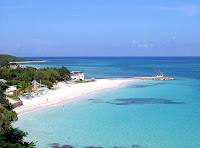skip to main |
skip to sidebar

- Jamaica is the largest English-speaking island in the Caribbean and the third largest overall. The island spans 4,400 square miles.
- Jamaica is populated by over 2 million people, largely descendents of the freed African slaves brought over to the island by the spanish and British. Jamaica is classified as a developing country. Tourism and mining are the two most profitable economic sectors along with agriculture and manufacturing. Jamaica has been an independent country since 1962 when it ceased to be a British colony but remains part of the British Commonwealth.
- Jamaica is an independent nation and a member of the British Commonwealth. After enjoying full internal self-government for a number of years Jamaica achieved independence in August of 1962. Queen Elizabeth II however, is still Queen of Jamaica by tradition and the titular head of state is her representative on the island—the Governor General. It is similar to Canada.
- Jamaica is the third largest Caribbean island, measuring 146 miles at its widest point. Primarily of volcanic origin, the lush island features a mountain ridge that peaks at Blue Mountain which is 7,402 feet high. Many white-sand beaches and clear seas ring the island.
- Democracy is complete, with an elected Parliament, a Prime Minister, an elected House of Representatives and a Senate. It works on similar lines to the British parliament. The constitution embodies absolute safeguards to personal liberties and democratic rule of law.
- Parliament sits at Gordon House on Kingston's Duke Street and visitors can watch proceedings from the visitors gallery.
- Population standing at 2,731, 832 at the end of 2005 is made up of the following approximate ethnic groups: African 76.3%, Afro-European 15.1%, European 0.8%, Chinese and Afro-Chinese 1.2%, East Indian and Afro-East Indian 3.4% and others 3.4%.
- Arawak Indians were the original inhabitants exterminated by the Spanish after Columbus discovered Jamaica in 1492. The Spanish were defeated by the British in 1655.
- Snakes are extremely rare. They were killed off by the mongoose, imported to exterminate canefield rats.
- Climate is year-round summer with no definite rainy season, although it usually rains most in May and October. North-easterly trade winds blow continually.
- Obeahism the Jamaican form of Voodoo exists but is seldom heard of. The Obeah man is supposed to marshal evil spirits to bring good or bad fortune. The practice of Obeahism is a still considered a crime punishable by imprisonment here.
- Industries in order of importance are tourism bauxite, agriculture (sugar, bananas, coffee, pimento, cocoa and tobacco). No other country in the world produces pimento, also known as Allspice.
- Orchids grow wild all over Jamaica—200 species of them, 73 of which are found nowhere else. There are also 500 species of fern and 1,000 species of trees.
- Blue Moons happen in Jamaica. Sapphire-coloured moons have been observed half a dozen times during the last 40 years.
- The Coconut Palm is not native to Jamaica or the West Indies. Surprisingly nor are sugar cane, bananas, mangoes, breadfruit or bamboo. They were all brought to the island at various stages in its history. The original Arawak inhabitants lived mainly on corn, fish and yams.
- Unexplored country still exists in the Cockpit Country, part of which is inhabited by the Maroons, slaves turned loose by the Spanish before they fled the island, and who went to this wild country to form settlements. They later harassed the British so much they were granted independence in a treaty of 1734 and still govern themselves today.
- Miscellaneous Departure Tax-Most important to remember, you will be asked to pay a departure tax of US$22 unless it was already calculated into your ticket when you bought it.
- Official Matter Entry Regulations- No passports are required of Canadian or U.S. Citizens/Residents entering as tourists for any period up to six months provided that they have a return ticket and identification such as a social security card or driver's license. All other visitors must carry a valid passport.
- Your home country may however impose other travel requirements in order for you to leave and return. Please check with your local officials for more information and to prevent any confusion.
- Visitors can obtain a special licence after a 24-hour period on the island. You must produce your passport and two witnesses. If either party has been divorced or widowed, necessary documents must be produced to vouch for their current status. Young people under 21 years of age must produce written consent from a parent, signed by a notary public.
- Jamaica's currency is the Jamaican dollar, not to be confused with the U.S. dollar. The value of the Jamaican dollar fluctuates but in November 2004 it was approximately JA$61 to US$1
- With a size of 4411 square miles, Jamaica is a little smaller than the state of Connecticut in U.S. Jamaica has a length of 146 miles and a width of 22-51 miles. The annual population growth is 0.46%.Hot and humid weather conditions typical of a tropical climate, with a temperate interior, prevails in Jamaica. The average annual rainfall is 78 inches. Some significant places in Jamaica are: Kingston/ Montego Bay/ Mandeville/ Port Antonio/ Ocho Rios/ Negril/
- Though the locals speak Jamaican language-Patois, the official language is English. The Ethnic groups comprising Jamaica are: Black (90.9%), mixed (7.3%), East Indian (1.3%), White (0.2%), Chinese (0.2%). The dominant religion of Jamaica is Christianity. Natural resources of Jamaica include bauxite, gypsum and limestone. The major exports of the country are bauxite, sugar, coffee, citrus products, rum, cocoa etc. The GDP per capita of Jamaica is US 3350.





1 comments:
I must digg your article therefore other people are able to look at it, really helpful, I had a hard time finding the results searching on the web, thanks.
- Norman
Post a Comment